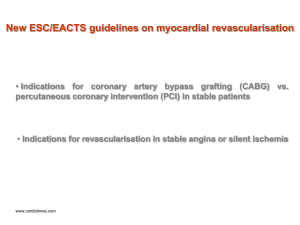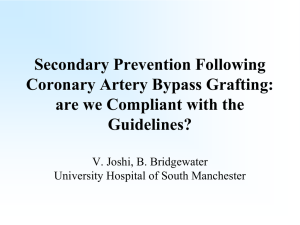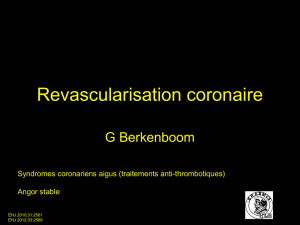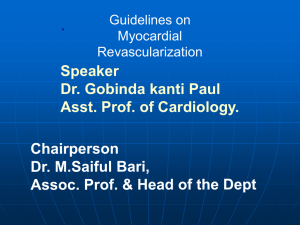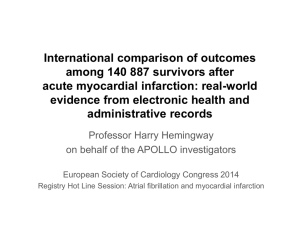Contra - SBHCI
advertisement
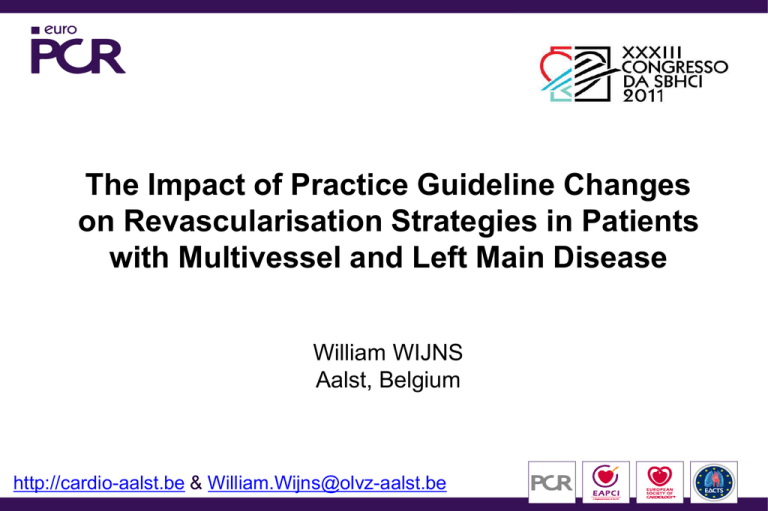
The Impact of Practice Guideline Changes on Revascularisation Strategies in Patients with Multivessel and Left Main Disease William WIJNS Aalst, Belgium http://cardio-aalst.be & William.Wijns@olvz-aalst.be The Impact of Practice Guideline Changes on Revascularisation Strategies in Patients with Multivessel and Left Main Disease William WIJNS Aalst, Belgium http://cardio-aalst.be & William.Wijns@olvz-aalst.be Joint ESC - EACTS Guidelines on Myocardial Revascularisation Joint Task Force on Myocardial Revascularisation of the European Society of Cardiology (ESC) and the European Association for CardioThoracic Surgery (EACTS) Developed with the special contribution of the European Association for Percutaneous Cardiovascular Interventions (EAPCI) European Heart Journal (2010) 31, 2501-2555 European Journal of CardioThoracic Surgery 38, S1 (2010) S1-S52 www.escardio.org/guidelines Previous ESC Guidelines The following ESC Guidelines are very relevant for Myocardial Revascularisation and served as background and foundation for our Task Force: Silber S, Albertsson P, Aviles FF, et al. Guidelines for percutaneous coronary interventions. The Task Force for Percutaneous Coronary Interventions of the European Society of Cardiology. Eur Heart J 2005;26:804-847. PCI in 2005 Fox K, Garcia MA, Ardissino D, et al. Guidelines on the management of stable angina pectoris: executive summary: The Task Force on the Management of Stable Angina Pectoris of the European Society of Cardiology. Eur Heart J 2006;27:1341-1381. Stable CAD in 2006 Bassand JP, Hamm CW, Ardissino D, et al. Guidelines for the diagnosis and treatment of non-ST-segment elevation acute coronary syndromes. Eur Heart J 2007;28:1598-1660. NSTE-ACS in 2007 Van De Werf F, Bax J, Betriu A, et al. Management of acute myocardial infarction in patients presenting with persistent ST-segment elevation: the Task Force on the Management of ST-Segment Elevation Acute Myocardial Infarction of the European Society of Cardiology. Eur Heart J 2008;29:2909-2945. STEMI in 2008 www.escardio.org/guidelines Joint 2010 ESC - EACTS Guidelines on Myocardial Revascularisation Joint ESC – EACTS Guidelines on Myocardial Revascularisation ● First (ever) document based on consensus opinion between clinical cardiologists, interventional cardiologists and cardiac surgeons ● First available Guidelines on MYOCARDIAL REVASCULARISATION. Therefore, more than 70% of the recommendations are new compared to previous ESC guidelines ● Out of 273 recommendations, level of evidence was A in 28%, B in 43% and C in 29% www.escardio.org/guidelines Joint 2010 ESC - EACTS Guidelines on Myocardial Revascularisation Parachutes appear to reduce the risk of injury but ... their effectiveness has not been proved with randomised controlled trials Level of Evidence = C Evidence of the « C » level is not necessarily weak! www.escardio.org/guidelines Joint 2010 ESC - EACTS Guidelines on Myocardial Revascularisation New, Debated or Controversial Issues ● Patient information and process for decision making ● Risk stratification and use of risk scores ● Heart Team ● Issues related to self-referral and “ad hoc” PCI ● PCI vs CABG for multivessel and left main disease ● Revascularisation vs OMT only for stable CAD ● CAD and co-morbidities: diabetes, CKD, PAD, ... ● Secundary prevention and OMT post-revascularisation www.escardio.org/guidelines Joint 2010 ESC - EACTS Guidelines on Myocardial Revascularisation The Heart Team Clinical cardiologist (non interventional) The patient with CAD Interventional cardiologist Cardiac surgeon Task Force composition = 7 clinical cardiologists (non interventional) + 9 interventional cardiologists + 7 cardiac surgeons www.escardio.org/guidelines Joint 2010 ESC - EACTS Guidelines on Myocardial Revascularisation Joint ESC – EACTS Guidelines on Myocardial Revascularisation Chairpersons & Task Force members William Wijns Cardiovascular Center Aalst Philippe Kolh Cardiovascular Surgery Department Liège Carlo Di Mario Nicolas Danchin Volkmar Falk Stefan James Jean Marco Miodrag Ostojic Nicolaus Reifart Flavio Ribichini Martin Schalij Patrick Serruys Sigmund Silber Scot Garg Kurt Huber Juhani Knuuti Jose Lopez-Sendon Massimo Piepoli Charles Pirlet Thirry Folliguet Lorenzo Menicanti Jose-Luis Pomar Paul Sergeant Miguel Sousa Uva David Taggart www.escardio.org/guidelines Joint 2010 ESC - EACTS Guidelines on Myocardial Revascularisation www.escardio.org/guidelines Joint 2010 ESC - EACTS Guidelines on Myocardial Revascularisation www.syntaxscore.com www.escardio.org/guidelines Joint 2010 ESC - EACTS Guidelines on Myocardial Revascularisation CABG PCI Tasks for each local Heart Team • To organise morbidity and mortality conferences and review institutional results in all transparency for benchmarking and guidance in decision making • To ensure proper patient information and consent, including adequate discussion of alternatives, risks and benefits, short and longer term, avoiding anonymous treatment • To design specific institutional protocols for disposal of patients with STEMI, NSTEMI, other ACS and stable CAD who should be treated ad hoc, or not • To define clinical care pathways, accounting for lesion subsets, and compatible with the current Guidelines, to avoid systematic case by case review of all diagnostic angiograms www.escardio.org/guidelines Joint 2010 ESC - EACTS Guidelines on Myocardial Revascularisation The Impact of Practice Guideline Changes on Revascularisation Strategies in Patients with Multivessel and Left Main Disease William WIJNS Aalst, Belgium http://cardio-aalst.be & William.Wijns@olvz-aalst.be Indications for revascularisation in patients with stable or acute coronary artery disease ● Depending on its symptomatic, functional and anatomic complexity, CAD can be treated by Optimal Medical Therapy (OMT) alone or combined with revascularisation using PCI or CABG ● The two issues to be addressed are: – the appropriateness of revascularisation – the relative merits of CABG and PCI in different patterns of CAD ● Revascularisation can be readily justified: – on prognostic grounds in certain anatomical patterns of CAD or a proven significant ischaemic territory or acute CAD – on symptomatic grounds in stable patients with persistent limiting symptoms despite OMT www.escardio.org/guidelines Revascularisation versus Medical Therapy after Stress SPECT: Survival Analysis These two lines intersect at a value of ~ 10% of ischaemic myocardium, above which the survival benefit for revascularization over medical therapy increases as a function of increasing amounts of inducible ischemia Hachamovitch et al. Circulation 2003;107:2900-6. www.escardio.org/guidelines Joint 2010 ESC - EACTS Guidelines on Myocardial Revascularisation Indications for revascularisation in stable angina or silent ischaemia Subset of CAD by anatomy For symptoms For prognosis Class Level I A IIa B No limit symptoms with OMT III C Subset of CAD by anatomy Class Level Left main > 50%* I A Any proximal LAD > 50%* I A 2VD or 3VD with impaired LV function* I B Proven large area of ischaemia (> 10% LV) I B Single remaining patent vessel > 50% stenosis* I C 1VD without proximal LAD and without > 10% ischaemia III A Any stenosis > 50% with limiting angina or angina equivalent, unresponsive to OMT Dyspnoea/CHF and > 10% LV ischaema/viability supplied by > 50% stenotic artery * With documented ischaemia or Fractional Flow Reserve (FFR) < 0.80 for % diameter stenosis by angiography between 50 and 90 % www.escardio.org/guidelines Pressure wire pullback Adenosine iv Distal LAD Distal LAD Proximal LAD A04/19 Specific PCI devices and pharmacotherapy www.escardio.org/guidelines Joint 2010 ESC - EACTS Guidelines on Myocardial Revascularisation Appropriateness of revascularisation method for advanced coronary artery disease ACCF / SCAI / STS / AATS / AHA / ASNC 2009 report Patel MR et al. JACC 2009;53:530-53 A = appropriate www.escardio.org/guidelines U = uncertain I = inappropriate Joint 2010 ESC - EACTS Guidelines on Myocardial Revascularisation Indications for CABG versus PCI in stable patients with lesions suitable for both procedures and low predicted surgical mortality Subset of CAD by anatomy Favours CABG Favours PCI IIb C IC 1VD or 2VD - proximal LAD IA IIa B 3VD simple lesions, full functional revascularisation achievable with PCI, SYNTAX score ≤ 22 IA IIa B 3VD complex lesions, incomplete revascularisation achievable with PCI, SYNTAX score > 22 IA III A Left main (isolated or 1VD, ostium/shaft) IA IIa B Left main (isolated or 1VD, distal bifurcation) IA IIb B Left main + 2VD or 3VD, SYNTAX score ≤ 32 IA IIb B Left main + 2VD or 3VD, SYNTAX score ≥ 33 IA III B 1VD or 2VD - non-proximal LAD In the most severe patterns of CAD, CABG appears to offer a survival advantage as well as a marked reduction in the need for repeat revascularisation www.escardio.org/guidelines MACCE to 3 Years by SYNTAX Score Tercile Low Scores (0-22) CABG (N=171) TAXUS (N=181) 3VD Cumulative Event Rate (%) 40 30 P=0.45 CABG PCI P value Death 6.8% 7.3% 0.86 CVA 3.2% 1.2% 0.20 MI 4.9% 5.1% 0.93 Death, CVA or MI 12.3% 11.2% 0.75 Revasc. 11.6% 18.8% 0.06 25.8% 22.2% 20 10 0 0 12 24 Months Since Allocation Cumulative KM Event Rate ± 1.5 SE; log-rank P value 36 Site-reported Data; ITT population Indications for CABG versus PCI in stable patients with lesions suitable for both procedures and low predicted surgical mortality Subset of CAD by anatomy Favours CABG Favours PCI IIb C IC 1VD or 2VD - proximal LAD IA IIa B 3VD simple lesions, full functional revascularisation achievable with PCI, SYNTAX score ≤ 22 IA IIa B 3VD complex lesions, incomplete revascularisation achievable with PCI, SYNTAX score > 22 IA III A Left main (isolated or 1VD, ostium/shaft) IA IIa B Left main (isolated or 1VD, distal bifurcation) IA IIb B Left main + 2VD or 3VD, SYNTAX score ≤ 32 IA IIb B Left main + 2VD or 3VD, SYNTAX score ≥ 33 IA III B 1VD or 2VD - non-proximal LAD In the most severe patterns of CAD, CABG appears to offer a survival advantage as well as a marked reduction in the need for repeat revascularisation www.escardio.org/guidelines MACCE to 3 Years by SYNTAX Score Tercile Low Scores (0-22) CABG (N=104) TAXUS (N=118) CABG Left Main Cumulative Event Rate (%) 40 30 P=0.33 23.0% 20 18.0% 10 PCI P value Death 6.0% > 2.6% 0.21 CVA 4.1% > 0.9% 0.12 < 4.3% 0.36 Death, CVA or MI 11.0% > 6.9% 0.26 Revasc. 13.4% < 15.4% 0.69 MI 2.0% 0 0 12 24 Months Since Allocation Cumulative KM Event Rate ± 1.5 SE; log-rank P value 36 Site-reported Data; ITT population MACCE to 3 Years by SYNTAX Score Tercile Intermediate Scores (23-32) CABG (N=92) TAXUS (N=103) CABG Left Main Cumulative Event Rate (%) 40 30 P=0.90 23.4% 23.4% 20 10 PCI P value Death 12.4% > 4.9% 0.06 CVA 2.3% > 1.0% 0.46 < 5.0% 0.63 MI 3.3% Death, CVA or MI 15.6% > 10.8% 0.29 Revasc. 14.0% < 15.9% 0.75 0 0 12 24 Months Since Allocation Cumulative KM Event Rate ± 1.5 SE; log-rank P value 36 Site-reported Data; ITT population MACCE to 3 Years by SYNTAX Score Tercile Left Main SYNTAX Score 33 CABG (N=149) TAXUS (N=135) Cumulative Event Rate (%) 40 CABG Left Main P=0.003 Death 7.6% PCI < 13.4% P value 0.10 37.3% CVA 30 21.2% 20 MI Death, CVA or MI 10 4.9% > 6.1% 1.6% 0.13 < 10.9% 0.18 15.7% < 20.1% 0.34 0 0 12 24 Months Since Allocation Cumulative KM Event Rate ± 1.5 SE; log-rank P value 36 Revasc. 9.2% < 27.7% <0.001 Site-reported Data; ITT population Indications for CABG versus PCI in stable patients with lesions suitable for both procedures and low predicted surgical mortality Subset of CAD by anatomy Favours CABG Favours PCI IIb C IC 1VD or 2VD - proximal LAD IA IIa B 3VD simple lesions, full functional revascularisation achievable with PCI, SYNTAX score ≤ 22 IA IIa B 3VD complex lesions, incomplete revascularisation achievable with PCI, SYNTAX score > 22 IA III A Left main (isolated or 1VD, ostium/shaft) IA IIa B Left main (isolated or 1VD, distal bifurcation) IA IIb B Left main + 2VD or 3VD, SYNTAX score ≤ 32 IA IIb B Left main + 2VD or 3VD, SYNTAX score ≥ 33 IA III B 1VD or 2VD - non-proximal LAD In the most severe patterns of CAD, CABG appears to offer a survival advantage as well as a marked reduction in the need for repeat revascularisation www.escardio.org/guidelines Classes of Recommendations is recommended should be considered may be considered is not recommended www.escardio.org/guidelines Joint 2010 ESC - EACTS Guidelines on Myocardial Revascularisation Consensus Heart Team Agreement Acceptable for CABG Not acceptable for CABG Acceptable for PCI Randomization in randomized trial Follow-up in PCIonly registry Not acceptable for PCI Follow-up in CABGonly registry Registry arms in SYNTAX PCI-only registry (CABG not acceptable) in 198 patients CABG not feasible because of co-morbidity in 71 % or lack of graft material in 9 % CABG-only registry (PCI not acceptable) in 1.077 patients PCI not feasible because coronary anatomy was not suitable in 92 % (including 22% CTO) Unfavourable anatomy is the only reason for not performing PCI in the DES era: feasibility = indication Integrated decision-making process The objective is to propose the best possible treatment to each individual patient with any presentation of CAD Reflect and apply the available the scientific evidence Is that evidence relevant to this patient? Appraisal of the patient’s condition & risk Proposed treatment should account for the experience of the local team Properly inform the patient and consider his preferences SYNTAX Trial Patient Distribution: 3 VD CABG 72% PCI only 8% CABG + PCI Results of the SYNTAX trial suggest that 72 % of 3 VD patients are still best treated with CABG; however, for the remaining patients PCI is an alternative to surgery at least for 3 years 20% PW Serruys et al. SYNTAX Trial Patient Distribution: LM Surgery For LM Still gold standard 66% PCI LM Legitimate 34% PW Serruys et al. Results of the SYNTAX trial suggest that 34 % of all patients with Left Main Stem disease are best treated with PCI, an excellent alternative to surgery … up to three years The Impact of Practice Guideline Changes on Revascularisation Strategies in Patients with Multivessel and Left Main Disease William WIJNS Aalst, Belgium http://cardio-aalst.be & William.Wijns@olvz-aalst.be Impact of the ESC – EACTS Myocardial Revascularisation Guidelines ● ESC requested endorsement from its National Societies ● Guidelines have been endorsed by nearly all ESC constituent bodies ● Guidelines were endorsed by a number of National Surgical Societies ● The Heart Team concept has been heavily discussed is some countries ● Changes in practice have been reported ● No reports yet of potential impact on patient outcome www.escardio.org/guidelines Joint 2010 ESC - EACTS Guidelines on Myocardial Revascularisation Disclosures for William Wijns Cardiovascular Center Aalst, Belgium • Consulting Fees: on my behalf go to the Cardiovascular Research Center Aalst • Contracted Research between the Cardiovascular Research Center Aalst and several pharmaceutical and device companies • Ownership Interest: Cardiovascular Research Center Aalst is cofounder of Cardio³BioSciences, a start-up company focusing on cellbased regeneration cardiovascular therapies Watch for your “Team” member! • “All this stent affair is a direct continuous of an non-responsible behavior of the cardiologist community. We are talking about many patients who are living with a ‘time-ticking bomb’ in their body. The cardiologists are ‘light headed’ in their attitude towards repeated revascularization procedure. If the patients needs more and more catheter-based procedures, their quality of life would be jeopardized and deteriorate.” • “The cardiologists are the ‘gate keepers’ as they both diagnose and treat the cardiac patients. When the poor patient lay on the table and the a catheter is inserted into his groin, he does not get a fair chance to decide what is best for him, e,g, stent or surgery. The tremendous pressure of the stent maker companies with the financial interest existing in the private catheterization sector, are the reason that patients would undergo catheterizations again and again without obtaining the relevant information concerning their situation. Yediot Journal 17.12.2006 “Stents in the arteries: a ticking bomb or a huge achievement?” Evidence basis for myocardial revascularisation Optimal medical therapy versus CABG ● Survival benefit of CABG in patients with Left Main or three vessel CAD, particularly when it involved the proximal LAD coronary artery ● Benefits were greater in those with severe symptoms, early ischaemia during stress testing and impaired LV function ● Both optimal medical therapy and CABG have improved lately www.escardio.org/guidelines Evidence basis for myocardial revascularisation Optimal medical therapy versus PCI ● Most meta-analyses reported no mortality benefit but: – increased non-fatal peri-procedural MI – reduced need for repeat revascularisation with PCI ● COURAGE Trial – At a median follow-up of 4.6 years, there was no significant difference in the composite of death, MI, stroke, or hospitalisation for unstable angina – Freedom from angina was greater by 12% in the PCI group at one year but was eroded by five years www.escardio.org/guidelines Potential indications for ad hoc PCI versus revascularisation at an interval • Ad hoc PCI is convenient for the patient, associated with fewer access site complications, and often cost-effective. • Ad hoc PCI is reasonable for many patients, but not desirable for all, and should not be automatically applied as a default approach. www.escardio.org/guidelines Joint 2010 ESC - EACTS Guidelines on Myocardial Revascularisation Potential indications for ad hoc PCI versus revascularisation at an interval • Hospital teams without a cardiac surgical unit or with interventional cardiologists working in an ambulatory setting should refer to standard evidence-based protocols designed in collaboration with an expert interventional cardiologist and a cardiac surgeon, or seek their opinion for complex cases. www.escardio.org/guidelines Joint 2010 ESC - EACTS Guidelines on Myocardial Revascularisation Recommendations for decision making and patient information time ? informed ? www.escardio.org/guidelines Joint 2010 ESC - EACTS Guidelines on Myocardial Revascularisation Patient information and consent When asked, most patients will prefer the less invasive PCI over surgery MACCE to 3 Years by SYNTAX Score Tercile Intermediate Scores (23-32) CABG (N=208) TAXUS (N=207) 3VD Cumulative Event Rate (%) 40 30 29.4% P=0.003 20 16.8% 10 CABG PCI P value Death 5.7% 10.3% 0.09 CVA 3.6% 2.5% 0.53 MI 3.1% 8.9% 0.01 Death, CVA or MI 11.3% 16.1% 0.16 Revasc. 8.4% 18.2% 0.004 0 0 12 24 Months Since Allocation Cumulative KM Event Rate ± 1.5 SE; log-rank P value 36 Site-reported Data; ITT population MACCE to 3 Years by SYNTAX Score Tercile High Scores (33) CABG (N=166) TAXUS (N=155) 3VD Cumulative Event Rate (%) 40 P=0.004 31.4% 30 20 17.9% 10 CABG PCI P value Death 4.5% 11.1% 0.03 CVA 1.9% 4.3% 0.28 MI 1.9% 7.2% 0.02 Death, CVA or MI 8.3% 17.7% 0.01 Revasc. 10.5% 21.5% 0.006 0 0 12 24 Months Since Allocation Cumulative KM Event Rate ± 1.5 SE; log-rank P value 36 Site-reported Data; ITT population
